The government will step on to the new year with rapid penetration of electric vehicles and expansion of road networks after aiming to turn the pandemic-induced “crisis into an opportunity” with ongoing construction of tunnel roads in terrain and essential infrastructure.
Massive construction work in the country’s roads and highways sector is either underway or launched or completed in 2020 such as projects from Kailash Mansarovar route to Zojila tunnel to Lipulekh pass.
Union Minister Mr. Nitin Gadkari said, “the key driver for the expansion of roadways and various infrastructure development projects, is the government’s decision to turn the crisis into an opportunity.” Currently, the total length of national highways is about 1,34,400 kilometres, with the goal of adding another 60,000 kilometres in five years’ time.
“We decided to turn it (crisis) into an opportunity and in rough terrain, including tunnels below Chamba town, major work was done on Kailash Mansarovar Yatra route and other strategic highways.”
In 2020, the government initiated project to provide all-year connectivity between Srinagar Valley and Leh for the strategic 14.15 kilometre long Zojila tunnel.
The Border Roads Organisation (BRO) completed a significant part of the road connectivity work from Dharchula to Lipulekh, widely known as the Kailash Mansarovar Yatra path. The strategically significant line connects the Lipulekh pass along the border with China in Uttarakhand with Dharchu at a height of 17,000 feet.
Mr. Gadkari said, “In the Jammu and Kashmir area , seven tunnel roads are under construction, including the development of the 8,450 metre-long twin-tube tunnel between Qazigund and Banihal, which will be completed by March 2021. Work is scheduled to be completed in December 2021 on the 2,968 metre long 6-single tunnel road between Ramban and Banihal.”
“Around 85% of the work on the Kailash Mansarovar route has been achieved and the remaining work is anticipated to be completed by April 2021.”
The aim for the construction of 60,000 kilometres of national highway over the next five years has been established through various programmes. The project is in full flow, including Rs. 1 lakh crore (US$ 14 billion) express corridor for Delhi-Mumbai, which the government is assured of completing in the next two years. Around 50% of the corridor construction has been completed. There are also 22 new express highways on the Anvil, including the Chennai-Bangalore one, which will help reduce the total cost of logistics.
With India’s determination to decrease carbon emissions by 30-35% by 2030 and efforts to minimise crude oil imports worth Rs. 8 lakh crore (US$ 110 billion), the focus is also on green fuel and electricity as well as electric vehicles (EVs).
Mr. Gadkari said, “India has an oil surplus. The advantages of e-mobility systems are therefore enormous. By offering different incentives, the Centre plans to have an electric vehicle sales penetration of 30% for private vehicles, 70% for commercial cars, 40% for buses, and 80% for two and three-wheelers by 2030.”
In order to accelerate the adoption of electric vehicles, the government plans to create at least one e-charging kiosk at each of the approximately 69,000 petrol pumps across the country.
Ethanol can be another effective fuel in addition to electricity, the minister said and added that it could easily be taken from being a Rs. 22,000 crore (US$ 2.99 billion)-ethanol economy to Rs. 2 lakh crore (US$ 27 billion), which would create 25 lakh job opportunities.
Mr. Gadkari added, “We expect to allow up to 22% to be blended and for that 3,500 litres of ethanol would only be necessary for petrol while additional enormous diesel requirements will be required as there will be flex motors for cars on the trend of developed nations in the coming days.”
On the Cab Aggregator Guidelines, Mr. Gadkari said, “we are committed to formalising this industry to build a skilled workforce of drivers and operators who are trained in best practises and equipped with the skills necessary to bring an end to end connectivity.”
In order to facilitate wider participation of builders in HAM (Hybrid Annuity Model), EPC (Engineering, Procurement and Construction) and BOT (Build, Operate and Transfer) models, technical and financial requirements for eligibility have been simplified for fast-track highway construction.
By rescheduling and fast-tracking payment cycles, working capital requirements were simplified, releasing more than Rs. 8,000 crore (US$ 1.09 billion) worth of payments in the lockdown period.
Among other measures, the performance protection condition was removed to ease cash flow in the industry and funds worth Rs. 4,000 crore (US$ 542.97 million) were released while existing PPP contractors were compensated for losses either in HAM or BOT or TOT.
The aim is to establish highways worth Rs. 15 lakh crore (US$ 200 billion) in the 3-4 years. Mr. Gadkari said, “During my earlier tenure, I had ensured works worth Rs. 17 lakh crore (US$ 230 billion) in my combined ministries.”
Source: IBEF
You may also like
-
Dot Simplifies Approval Processes For Telecom Licenses And Wireless Equipment
-
PM to Inaugurate SEMICON India 2024 on 11th September
-
Shri Piyush Goyal Sets 500 Million Tonnes Domestic Steel Production Target by 2034
-
NHAI to Track Around 100 Toll Plazas with GIS-Based Software for Seamless Movement of Traffic at National Highways
-
“Marching Towards Building A Digitally Connected Bharat and An Atmanirbhar Telecom Sector”: Union Minister Jyotiraditya Scindia
